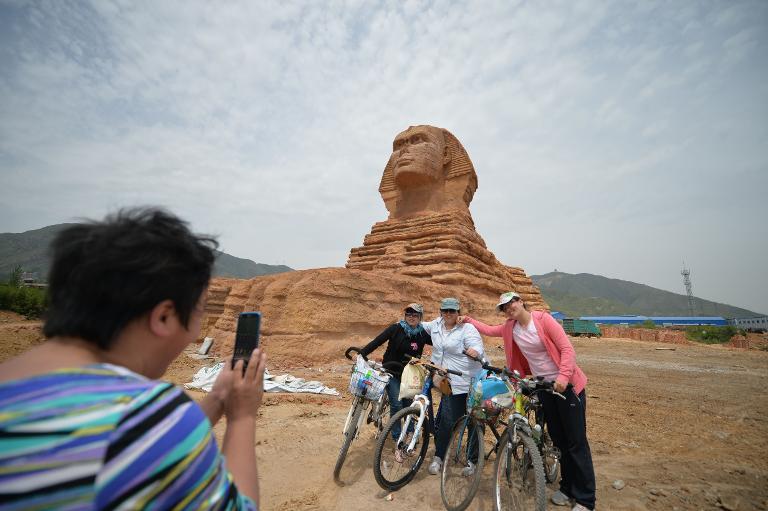
(AFP Photo)
China will demolish a life-size replica of the Sphinx in Hebei province after the Egyptian Ministry of Antiquities filed a complaint with UNESCO, calling the structure a threat to its cultural heritage, Chinese state media reported.
Located at the foot of the Taihang Mountains in China, the Sphinx’s replica is about 80 meters (264 feet) long and 30 meters tall. It is made of reinforced steel bars and a concrete body, unlike the Egyptian version of the Sphinx, which is carved from one piece of limestone.
Minister of Antiquities Mohamed Ibrahim announced earlier this month that Egypt was filing a complaint with the United Nations Educational, Scientific and Cultural Organization (UNESCO) about the Chinese imitation of the unique antiquity.
According to China’s official Xinhua news agency, the replica is just a temporary film prop, and will be dismantled as soon as filming is done.
“We are very respectful to world cultural heritage and express our apologies for any misunderstanding,” said an official with a cultural park on the outskirts of the provincial capital Shijiazhuang, who declined to be named.
The film in question was supported by an entertainment conglomerate based in southern China’s Hangzhou. The conglomerate has invested CNY $5m to build the theme park near another tourist attraction, the Dragon Spring Temple. The movie features a range of worldwide cultural heritages, according to state-Run Al-Ahram.
Egypt’s Ministry of Antiquities called on UNESCO to implement the convention it signed in 1972 concerning the protection of the world’s cultural and natural heritage. Ibrahim said he feared the replica would have a negative effect on the already struggling Egyptian tourism industry because it harms the country’s “cultural heritage”.
The 1972 UNESCO convention states that the right of identification, presentation and transmission of monuments to the future generation belongs only to the state that owns them. It emphasises the importance of safeguarding and protecting unique monuments, as they are considered irreplaceable property to the people.
Legal experts said, however, that Egypt’s complaint may be unenforceable.
“Egypt has no national law that copyrights its antiquities,” Mohamed Mahmoud, a lawyer at the Arabic Network for Human Rights Information, told Cairo Post.
Ali Atef, who also works as a lawyer at the Arabic Network for Human Rights, to the website that he didn’t think China would face a penalty for copying the monument, “Egypt did not copyright the Sphinx, and thus, China did not commit any violation.”
Already notorious for copying Western goods ranging from trainers to champagne, China is building up its replica reputation with a miniature Mount Rushmore, an Eiffel Tower and an entire Austrian village.
In the southwestern megacity of Chongqing, a park is scattered with sculptures including Michelangelo’s David, Rodin’s Thinker and the gigantic heads of four American presidents in a trend known as “duplitecture”.
An assemblage of Parisian monuments including the Eiffel Tower and a fountain from Versailles stand in the city of Hangzhou, as does a French village.
Among the most eye-popping examples are a copy of the Austrian alpine village and UNESCO World Heritage Site of Hallstatt in the southern province of Guangdong, which even state media called “a bold example of China’s knock-off culture”.
AFP contributed to this report


